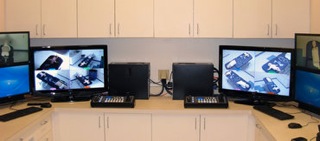- The Medical Arts Building consists of a clinical skills area/clinic, two simulator rooms, eight clinical exam rooms, a furnished video production/teleconference studio, and student government and faculty offices. Scott Daniel, president of Vision Integration—based out of Daphne, AL—provided the Medical Arts Building with the AV equipment to accommodate eight clinical exam rooms and two simulator rooms.
The eight clinical exam rooms are setup to emulate a Doctor’s examination room for use as a teaching tool to see students interact with patients. “They do 30-minute sessions twice a week and they wanted to be able to record each session so both students and professors can go back and watch them,” explained Daniels. “Each recorded session can be used for recording and evaluating student improvement, consistency and interaction with patients.”
These rooms are used primarily for practicing history, clinical and physical exams.
Dr. Judy L. Turner, D.O., chair of the Family Medicine Department, added, “The video capture allowed us [the faculty] to spread our resources a bit. We needed a way to test the students’ clinical and physical exam skills in an efficient, yet effective manner. Using the recordings, we can standardize the students’ results and eventually create a standardized patient program to review students for consistency.”
Each room is equipped with two high definition Vaddio WallVIEW HD-20 PTZ camera systems – one camera getting a tight shot of the patient on the examining table and another camera capturing a wide-shot of the entire room. “Each examination room is controlled from a single control room with three Vaddio ProductionVIEW Precision Camera Controllers connected to four quads," said Daniels. “So we get all 16 cameras on four 32-inch monitors with three controllers.”
There are also two simulation rooms with Laerdal full-body simulator men for teaching students how to interact with patients in a realistic manner, explained Turner. “These rooms are used primarily for second year Clinical Sciences classes for Basic Life Support (BLS), Advanced Life Support (ALS) and Pediatric Advanced Life Support (PALS) training. Students use plastic models of breasts and pelvises – leading to eventual practice on their classmates. The simulation rooms are also available for community-based training and Turner is hoping to eventually start collaborating with the Joseph and Nancy Fail School of Nursing, also located on the WCU campus.
Each simulation room has five Vaddio WallVIEW HD-20 camera systems. “One camera is placed in the center right over the gurney,” said Daniel. “And there are four more in each one of the corners of the room with presets – you name it – it’s the whole nine yards.”
Everything is being captured and recorded via DVR and is ultimately saved to the server or a DVD for students/professors to take home.











